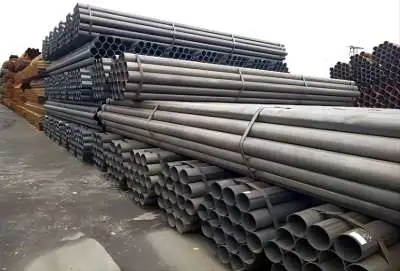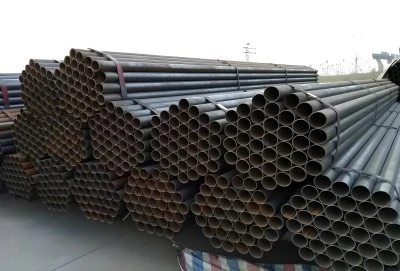Electric Resistance Welded (ERW) pipes are now used in a wide range of industries, including the oil and gas, construction, and infrastructure sectors. The assembling system of ERW pipe is an interesting excursion that changes level steel strips into vigorous, excellent lines. In this article, we'll plunge profound into the ERW pipe producing process, investigating the significant phases of steel strip planning, shaping, and electric obstruction welding.
|
|
|
Steel Strip Preparation: The Foundation of Quality ERW Pipes:
The selection and preparation of steel strips is the first step in the journey of an ERW pipe. Because the performance and durability of the finished product are directly influenced by the quality of the steel strip, this initial stage is crucial. Producers like Longma Gathering, known for their ability in ERW steel pipes, give fastidious consideration to this stage.
The first step is to locate high-quality steel coils with particular chemical and mechanical properties. The coils are then unwound and cut to the desired width, which is the finished pipe's circumference. The strip's edges are then meticulously prepared to guarantee a clean and precise weld later on.
ERW pipe is one of the most important steps in preparing steel strips. To create a uniform, clean surface, this procedure involves removing a small amount of material from the strip's edges. Edge processing is fundamental for accomplishing a top notch weld and forestalling surrenders in the completed ERW pipe.
The steel strip is thoroughly cleaned following edge milling to get rid of any contaminants that could affect the welding process. This might include synthetic cleaning, brushing, or different techniques to guarantee the steel surface is flawless and prepared for the following phase of creation.
Forming:
The forming stage follows the steel strip's preparation stage. This is where the level strip starts its change into a round and hollow shape, setting the establishment for the last ERW pipe. The shaping system is a fragile equilibrium of accuracy designing and controlled distortion.
The cycle ordinarily starts with a progression of framing rolls that continuously twist the steel strip into a round shape. The pipe's diameter and roundness are precisely set by calibrating these rolls. As the strip goes through progressive framing stations, it step by step takes on a more round and hollow shape.
Keeping the pipe's diameter and roundness consistent throughout its length is one of the main challenges of the forming process. High level ERW pipe makers utilize modern control frameworks and high-accuracy hardware to guarantee consistency. Producing ERW pipes that adhere to stringent industry standards and customer requirements necessitates this level of attention to detail.
As the strip approaches the finish of the shaping system, the edges are united to make a little hole, known as the weld crease. Because it directly affects the quality of the weld in the subsequent stage of production, this alignment's precision is crucial. Laser alignment systems are frequently utilized in contemporary ERW pipe manufacturing facilities to guarantee that the edges are precisely positioned for welding.
Electric Resistance Welding: The Heart of ERW Pipe Production:
The ERW pipe truly comes to life during the process of electric resistance welding. This stage is the climax of the cautious arrangement and shaping that goes before it, and it's here that the line acquires its primary uprightness and strength.
A high-frequency electric current is passed through the steel strip's edges where they meet in electric resistance welding. The intense heat generated by the steel's resistance to this current causes the edges to reach their melting point. Under painstakingly controlled pressure, these warmed edges are then fashioned together, making a nonstop, high-strength weld along the length of the line.
The speed and effectiveness of the ERW procedure are among its primary advantages. ERW relies on the steel of the pipe itself to form the weld, in contrast to other welding techniques that necessitate the addition of filler material. As a result, the joint is seamless and frequently blends in with the pipe wall as a whole.
Following welding, the line goes through a progression of cooling stations. Controlled cooling is critical for accomplishing the ideal metallurgical properties in the weld region. A few makers, including industry pioneers like Longma Gathering, utilize progressed cooling methods to streamline the line's mechanical properties.
ERW pipes go through stringent quality control checks after the welding and cooling processes. To ensure that the pipe meets or exceeds industry standards, these may include visual inspections, non-destructive testing methods like ultrasonic testing, and mechanical property tests.
Heat treatment to relieve internal stresses, straightening to ensure that the pipe meets straightness tolerances, and cutting to the desired length are typically the final steps in the ERW pipe manufacturing process. A few makers likewise offer extra administrations like end completing the process of, covering, or stringing, contingent upon the line's expected application.
Conclusion:
ERW pipe production is a complicated, multi-stage process that combines precise engineering with cutting-edge technology. Each step in the production of high-quality pipes that meet the stringent requirements of various industries is crucial, from the initial preparation of the steel strip to the final quality control checks.
The key steps of steel strip preparation, forming, and electric resistance welding work together to turn flat steel into sturdy, dependable pipes, as we've seen in this article. Organizations like Longma Gathering, with their mastery in ERW steel pipes and noteworthy yearly results surpassing a million tons, exhibit the scale and complexity of current ERW pipe fabricating.
Understanding these crucial stages provides valuable insight into the engineering marvel that is the ERW pipe, regardless of whether you are in the market for pipes or just curious about the manufacturing process. We can anticipate even more advancements in manufacturing as technology progresses, enhancing the quality, effectiveness, and adaptability of these essential industrial products.
Companies like Longma Group, which have been in the industry for a long time, can provide the expertise and high quality that project managers seeking ERW pipe manufacturers need. Contact info@longma-group.com if you are interested in learning more about their ERW pipe capabilities.














